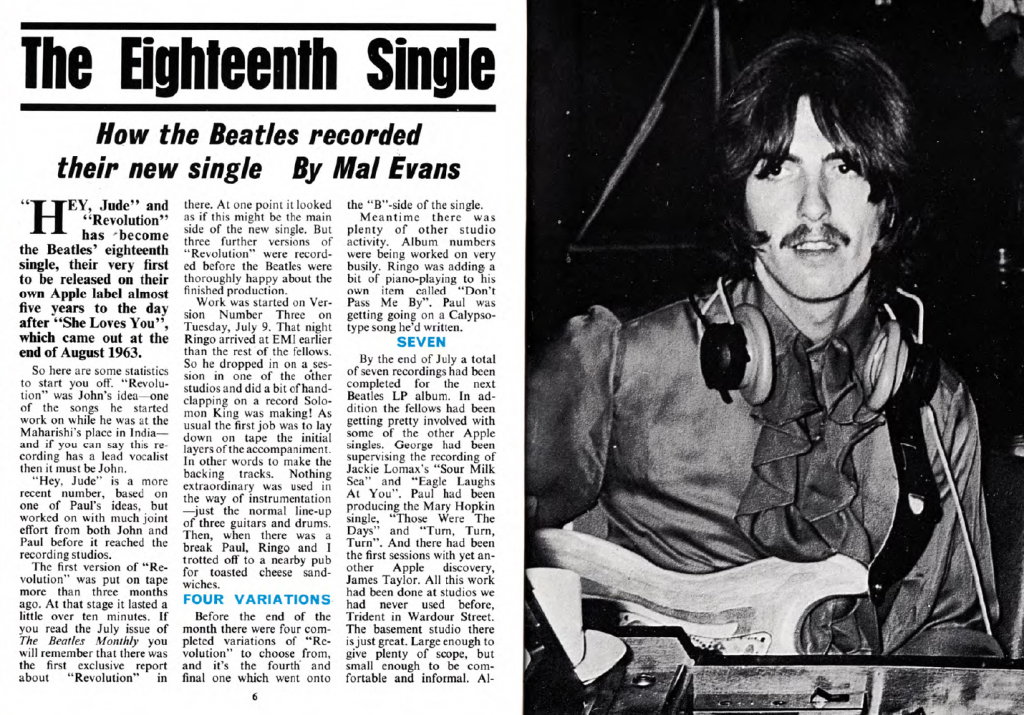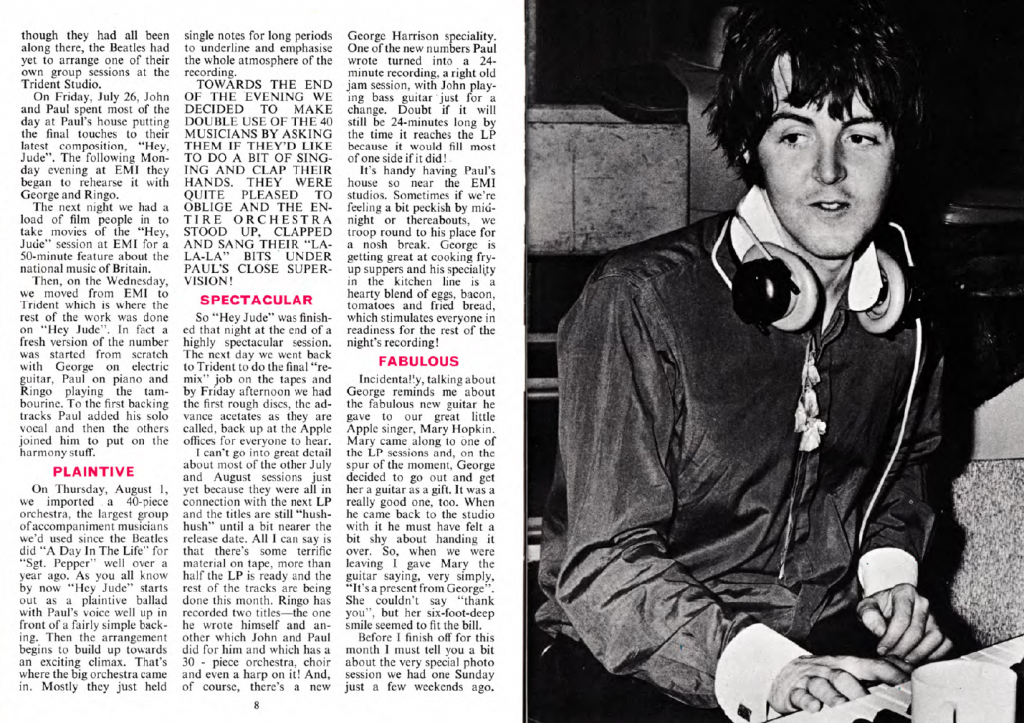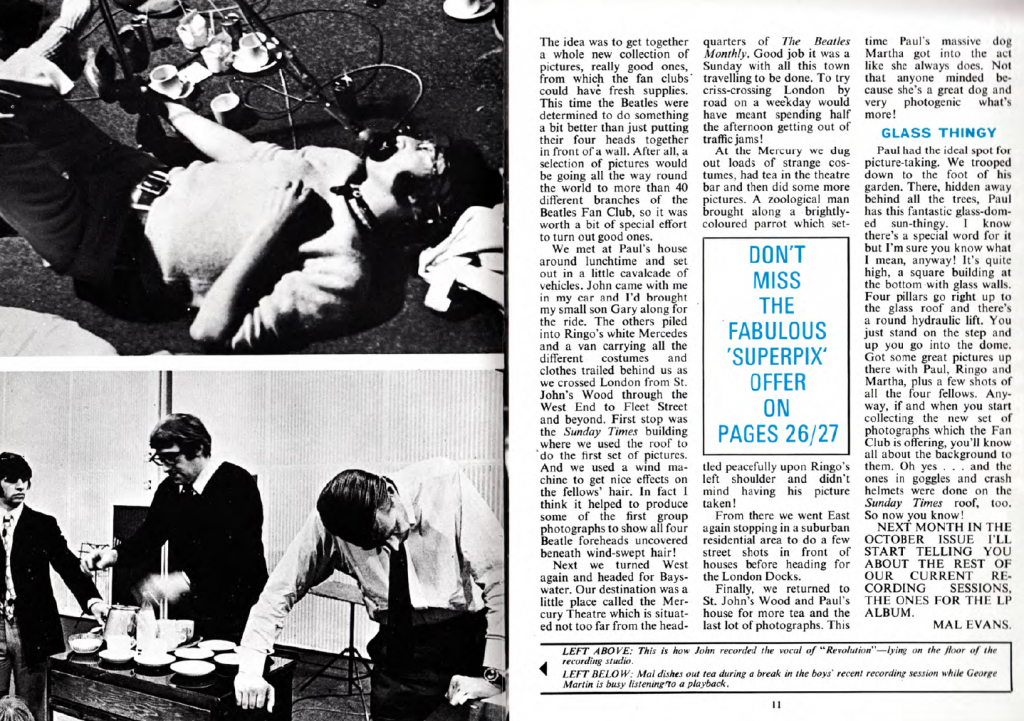US Release date : Monday, August 26, 1968
Hey Jude / Revolution
By The Beatles • 7" Single • Part of the collection “The Beatles • Singles”
Last updated on August 1, 2023
US Release date : Monday, August 26, 1968
By The Beatles • 7" Single • Part of the collection “The Beatles • Singles”
Last updated on August 1, 2023
Previous single May 06, 1968 • "Step Inside Love / I Couldn't Take My Eyes Off You" by Cilla Black released in the US
Session Aug 23, 1968 • Recording and mixing "Back In The U.S.S.R."
Session Aug 26, 1968 • Tape copying "Revolution 9"
Single Aug 26, 1968 • "Hey Jude / Revolution" by The Beatles released in the US
Single Aug 26, 1968 • "Those Were The Days / Turn! Turn! Turn!" by Mary Hopkin released in the US
Single Aug 26, 1968 • "Thingumybob / Yellow Submarine" by Black Dyke Mills Band released in the US
This album was recorded during the following studio sessions:
7:19 • Studio version • A • Mono
Paul McCartney : Bass, Piano, Vocals Ringo Starr : Backing vocals, Drums, Tambourine John Lennon : Acoustic guitar, Backing vocals George Harrison : Backing vocals, Electric guitar George Martin : Producer Ken Scott : Recording engineer Barry Sheffield : Recording engineer Bill Jackman : Flute Unknown musician(s) : Bassoon, Contrabass clarinet, Contrabassoon, Four trombones, Four trumpets, One flute, One percussionist, Ten violins, Three violas, Two cellos, Two clarinets, Two double basses, Two french horns John Perry : Backing vocals Bobby Kok : Cello
Session Recording & overdubs: Jul 31, 1968 • Studio Trident Studios, London, UK
Session Overdubs: Aug 01, 1968 • Studio Trident Studios, London, UK
Session Mixing: Aug 08, 1968 • Studio EMI Studios, Studio Two, Abbey Road
3:23 • Studio version • A • Mono
Paul McCartney : Bass guitar, Hammond organ, Handclaps Ringo Starr : Drums, Handclaps John Lennon : Electric guitar, Handclaps, Vocals George Harrison : Electric guitar, Handclaps Nicky Hopkins : Electric piano
Session Recording: Jul 10, 1968 • Studio EMI Studios, Studio Three, Abbey Road
Session Overdubs: Jul 11, 1968 • Studio EMI Studios, Studio Three, Abbey Road
Session Overdubs: Jul 12, 1968 • Studio EMI Studios, Studio Two, Abbey Road
Session Mixing: Jul 15, 1968 • Studio EMI Studios, Studio Two, Abbey Road
It’s nice to be at No. 1 but it’ll be nicer if Mary Hopkin gets there next week, which is the way it’s beginning to look at the moment!
We’d like to thank everybody for getting Apple off to a great start. The dreams are coming true, and nobody is more responsible than you out there.
Watch out for the Iveys. And James Taylor. And the “Wonderwall” LP. And the new Beatles album. We had you in mind!
Paul McCartney – about the “Hey Jude / Revolution” single reaching #1 – from New Musical Express, September 14, 1968
From Wikipedia:
[…] “Hey Jude” was recorded at the end of July 1968 during the sessions for The Beatles, but was issued separately as a single nearly three months before the album’s release. (It would, however, make its LP debut in the US two years later as the title cut of the compilation album Hey Jude) The B-side, “Revolution“, was a different version of the album’s “Revolution 1“. Lennon had wanted the original version of “Revolution” to be released as a single, but the other three Beatles objected on the grounds that it was too slow. Instead, the single featured a new, faster version, with heavily distorted guitar and an electric piano solo from Nicky Hopkins. This was the first release on Apple Records and went on to be the band’s most successful single, with world sales of over 5 million by the end of 1968 and 7.5 million by October 1972. […]
From the US press release:
“It is the Beatles again, doing it again, doing our minds in again with the magical mystic Beatle mastery of their medium. They are the message, are the medium. They have written and produced two sides for this new single which you know, you know beyond the thinnest wisp of a shadow of a doubt, will engage the most profound admiration from the public, from the industry, from those in other groups, who strive to match the Beatles achievements. ‘Hey Jude’ is lead sung by Paul McCartney and it is a long lovely loving love-song offering hope (‘Hey Jude, don’t be afraid… take a sad song and make it better…’) and beauty in the words and extraordinary melodic subtleties in the music. ‘Hey Jude’ is the longest song ever recorded by the Beatles (seven minutes and five seconds), and I would say it was the best if it weren’t for all those others that have gone before. I would say it was the best if, also, it were not that ‘Revolution’ — main voice John — were not so breathtaking vital and insistent. This is the new Beatle peace — with strength message, with the voices forced out of the grooves by a backing as new for Capitol now as Strawberry Fields was for then. A theme for today, ‘Revolution,’ written by revolutionary visionaries. The Beatles are without peer. Their music is magnificent. It can be said again and again as they sing and sing it again.”
Derek Taylor – From the US press release
“Hey Jude / Revolution” was one of the four first singles published by Apple Records ; and a limited edition press kit, called “Our First Four“, was issued in the UK. The four first Apple singles were:
| Single | UK Reference | UK release date |
| “Hey Jude / Revolution” by The Beatles | R 5722 | August 31, 1968 |
| “Those Were The Days / Turn, Turn, Turn” by Mary Hopkin | APPLE 2 | August 30, 1968 |
| “Sour Milk Sea / The Eagle Laughs at You”, by Jackie Lomax | APPLE 3 | August 26, 1968 |
| “Thingumybob / Yellow Submarine” by Black Dyke Mills Band | APPLE 4 | August 31, 1968 |
In the US, a different press kit was sent to radios. From Apple’s American Debut – The Original 1968 Press Kit | beatle.net:
On August 22, 1968, Apple Records’ Los Angeles office sent press kits to radio station program directors across the United States. The kits were packaged in white envelopes with an Apple logo in the upper left corner serving as the return address. The logo was a solid green circle with a white apple in the center with the word “Apple” in white script above the stem. The post mark indicated that the package cost a then hefty eighty cents to air mail. The lucky recipients of these envelopes would be among the first people in America to see and hear what the Beatles new Apple venture was all about. […]
For those disc jockeys who had been monitoring Apple’s progress by reading trade magazines, the arrival of the classy looking white envelope with the Apple logo was truly a magic moment. Upon ripping open the envelope, the recipient encountered a glossy cream colored folder with a large Apple logo on its front side. Inside was a treasure of sound, visuals and text.
In contrast to the white envelope and folder were four distinguished-looking black center cut record sleeves. One proclaimed “The Beatles on Apple” in an attractive script font. The group’s name was in white and Apple in green. The other three sleeves merely said “Apple” in the same eye-catching green script letters. Peeking out of the center of each sleeve was a record label covered with a Granny Smith green apple.
The sleeves were not the only thing different about the singles. While most records had the same label design on both sides, these discs had a full green apple on one side and a sliced apple was its exposed white innards on the other side. The singles also had something new to most Americans — a slip guard consisting of 360 interlocking serations surrounding the label. Although the tiny grooves appeared to be an innovation of Apple, several British labels had been pressing discs with slip guards for years. By coincidence, Capitol had re-tooled its pressing plants for slip guard singles at the beginning of the month, so the Apple singles were among the first Capitol manufactured titles to take on the new look. […]
The press kit also included two 8″ x 10″ black and white glossies of each of the artists featured on the records. The Beatles are represented by their cartoon images from the Yellow Submarine film. Paul and his sheep dog Martha are pictured with the Black Dyke Mills Band in the brass band’s horizontal publicity still. Jackie Lomax and the lovely looking Mary Hopkin are each featured in vertical pictures. All four glossies have the artist’s name printed below the picture towards the left side and the Apple logo in lower right corner.
Recipients of the press kit learned about each artist through separate 8 1/2″ x 11″ information sheets and 5 1/2″ x 8 1/2″ booklets. The text of the information sheets is credited to Apple press agent Derek Taylor. Although no credit is given in the booklets, the writing is appears to be the work of Derek Taylor as well. […]


From the Beatles Monthly Book, N°62, September 1968:
“HEY, Jude” and “Revolution” has become the Beatles’ eighteenth single, their very first to be released on their own Apple label almost five years to the day after “She Loves You”, which came out at the end of August 1963.
So here are some statistics to start you off. “Revolution” was John’s idea — one of the songs he started work on while he was at the Maharishi’s place in India — and if you can say this recording has a lead vocalist then it must be John.
“Hey, Jude” is a more recent number, based on one of Paul’s ideas, but worked on with much joint effort from both John and Paul before it reached the recording studios.
The first version of “Revolution” was put on tape more than three months ago. At that stage it lasted a little over ten minutes. If you read the July issue of The Beatles Monthly you will remember that there was the first exclusive report about “Revolution” in there. At one point it looked as if this might be the main side of the new single. But three further versions of “Revolution” were recorded before the Beatles were thoroughly happy about the finished production.
Work was started on Version Number Three on Tuesday, July 9. That night Ringo arrived at EMI earlier than the rest of the fellows. So he dropped in on a session in one of the other studios and did a bit of handclapping on a record Solomon King was making! As usual the first job was to lay down on tape the initial layers of the accompaniment. In other words to make the backing tracks. Nothing extraordinary was used in the way of instrumentation — just the normal line-up of three guitars and drums. Then, when there was a break Paul, Ringo and I trotted off to a nearby pub for toasted cheese sandwiches.
FOUR VARIATIONS
Before the end of the month there were four completed variations of “Revolution” to choose from, and it’s the fourth and final one which went onto the “B”-side of the single. Meantime there was plenty of other studio activity. Album numbers were being worked on very busily. Ringo was adding a bit of piano-playing to his own item called “Don’t Pass Me By”. Paul was getting going on a Calypso-type song he’d written.
SEVEN
By the end of July a total of seven recordings had been completed for the next Beatles LP album. In addition the fellows had been getting pretty involved with some of the other Apple singles, George had been supervising the recording of Jackie Lomax’s “Sour Milk Sea” and “Eagle Laughs At You”. Paul had been producing the Mary Hopkin single, “Those Were The Days” and “Turn, Turn, Turn”. And there had been the first sessions with yet another Apple discovery, James Taylor. All this work had been done at studios we had never used before, Trident in Wardour Street. The basement studio there is just great. Large enough to give plenty of scope, but small enough to be comfortable and informal. Although they had all been along there, the Beatles had yet to arrange one of their own group sessions at the Trident Studio.
On Friday, July 26, John and Paul spent most of the day at Paul’s house putting the final touches to their latest composition, “Hey, Jude”. The following Monday evening at EMI they began to rehearse it with George and Ringo.
The next night we had a load of film people in to take movies of the “Hey, Jude” session at EMI for a 50-minute feature about the national music of Britain.
Then, on the Wednesday, we moved from EMI to Trident which is where the rest of the work was done on “Hey Jude”. In fact a fresh version of the number was started from scratch with George on electric guitar, Paul on piano and Ringo playing the tambourine. To the first backing tracks Paul added his solo vocal and then the others joined him to put on the harmony stuff.
PLAINTIVE
On Thursday, August 1, we imported a 40-piece orchestra, the largest group of accompaniment musicians we’d used since the Beatles did “A Day In The Life” for “Sgt. Pepper’ well over a year ago, As you all know by now “Hey Jude” starts out as a plaintive ballad with Paul’s voice well up in front of a fuirly simple backing. Then the arrangement begins to build up towards an exciting climax. That’s where the big orchestra came in. Mostly they just held single notes for long periods to underline and emphasise the whole atmosphere of the recording.
TOWARDS THE END OF THE EVENING WE DECIDED TO MAKE DOUBLE USE OF THE 40 MUSICIANS BY ASKING THEM IF THEY’D LIKE TO DO A BIT OF SINGING AND CLAP THEIR HANDS. THEY WERE QUITE PLEASED TO OBLIGE AND THE ENTIRE ORCHESTRA STOOD UP, CLAPPED AND SANG THEIR “LA-LA-LA” BITS UNDER PAUL’S CLOSE SUPERVISION!
SPECTACULAR
So “Hey Jude” was finished that night at the end of a highly spectacular session. The next day we went back to Trident to do the final “remix” job on the tapes and by Friday afternoon we had the first rough discs, the advance acetates as they are called, back up at the Apple offices for everyone to hear.
I can’t go into great detail about most of the other July and August sessions just yet because they were all in connection with the next LP and the titles are still “hush-hush” until a bit nearer the release date. All I can say is that there’s some terrific material on tape, more than half the LP is ready end the rest of the tracks are being done this month. Ringo has recorded two titles — the one he wrote himself and another which John and Paul did for him and which has a 30-piece orchestra, choir and even a harp on it! And, of course, there’s a new George Harrison speciality. One of the new numbers Paul wrote turned into a 24-minute recording, a right old jam session, with John playing bass guitar just for a change. Doubt if it will still be 24-minutes long by the time it reaches the LP because it would fill most of one side if it did! […]
Mal Evans – From the Beatles Monthly Book, N°62, September 1968




Notice any inaccuracies on this page? Have additional insights or ideas for new content? Or just want to share your thoughts? We value your feedback! Please use the form below to get in touch with us.
[…] same summer. It was released as a single, the A-side to “Revolution.” From its original US press release, “Hey Jude” is described as “a long lovely loving love-song offering […]